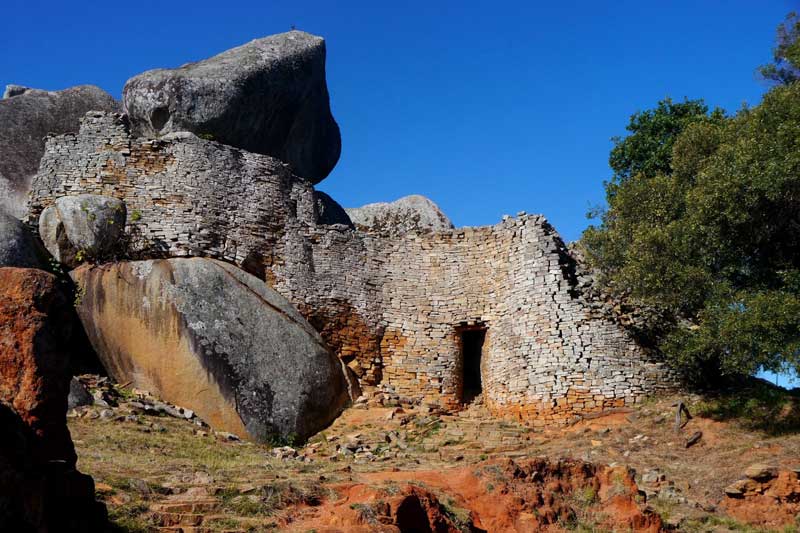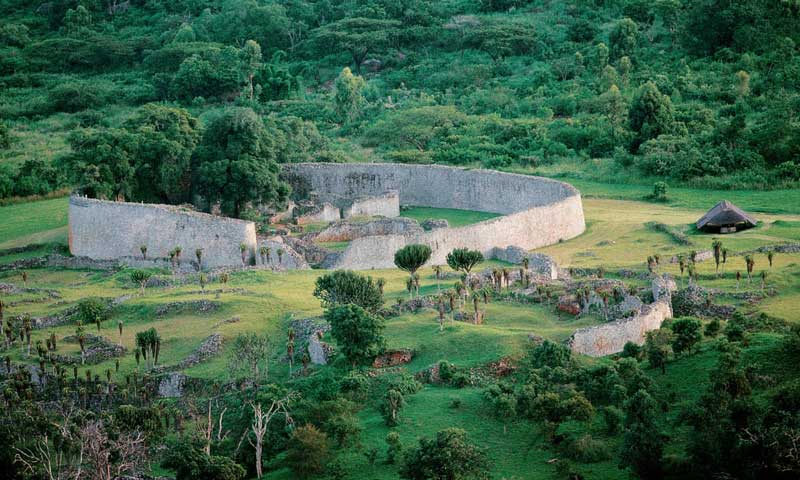
Located in the heart of southern Africa, between the Zambezi and Limpopo Rivers, the site of the Great Zimbabwe Ruins, that spread across the Zimbabwe Highveld, is known as ‘Zimbabwes’ and is clearly distinguished from the other hundreds of such small ruins in southern Africa. In fact, there are more than 150 of such stone ruins in southern Africa, such as the Bumbusi in Zimbabwe and Manikin in Mozambique and all are enriched with tall monumental walls constructed without mortar.
However, the Great Zimbabwe ruins ranks highest among all of them as the oldest and the largest and the most important collection of ruins in Africa. The ruins spanning around 1,800 acres of land indicate the presence of an ancient culture of great wealth and commendable architectural skill that had about 18,000 inhabitants at its peak.

In the language of the Shona people, who live in the region today, Zimbabwe means ‘big stone houses’ or ‘venerated houses’. As a matter of fact, the word Zimbabwe is made of two key root words, ‘mba’, meaning house and ‘bwe’, which means stone. Hence, the word Zimbabwe means ‘House of Stone’.

The German explorer Karl Mauch, who visited the site in 1871, refused to believe that indigenous Africans could have built such an extensive network of monuments and according to him, it was an African replica of the palace of the Biblical Queen of Sheba in Jerusalem and the hill is a copy of Solomon’s Temple on Mount Moriah. It was also maintained by many European writers that it was built by the Portuguese travellers, Arabs, Chinese or Persians, as the Africans did not have the capacity to build anything of the significance of Great Zimbabwe. According to another version, the site could have been the work of a southern African tribe of ancient Jewish heritage, the Lemba. However, due to its impressive size and perfect workmanship, the indigenous people living around the site were said to believe it was the work of demons or aliens.
Finally, the British archaeologist David Randall-Maclver concluded in1905, the ruins were medieval and built by one or more of the local African Bantu people, which was later confirmed by another British archaeologist, Gertrude Caton-Thompson in 1929. However, it is generally believed that it was built by the members of the Gokomere culture, who were ancestors of the modern Shona in Zimbabwe. Others believe that the ancestors of the Lemba or Venda were behind the construction or they cooperated with the Gokomere in the construction.

It is estimated that the Shona people first settled in the region more than 1,000 years ago and flourished in the lush green savannah plains of the region, which once supported a population of 10,000 to 20,000. While their economy was based on cattle husbandry, crop cultivation and the trade of gold, central to their prosperity was the ancient town of Great Zimbabwe, the capital of a thriving trading empire that flourished between the 11th and 15th centuries. Causes for the decline and ultimate abandonment of the site have been suggested as due to a decline in trade, political instability, famine and water shortages caused by the climatic change.

The Great Zimbabwe ruins are categorized into three distinct architectural groups, namely the Hill Complex, the Great Enclosure and the Valley Complex. Among the three groups, the Hill Complex, formerly called the Acropolis, is the oldest, which was occupied from the ninth to the thirteenth centuries. One of the notable features of the Hill Complex is a huge boulder in a shape similar to that of the Zimbabwe Bird, from where the king used to preside over the important rituals, such as the judgment of the criminals, the appeasing of the ancestors and sacrifices to rainmaker gods.
The complex is situated on a steep-sided hill that rises 262 feet (80 m) above the ground and its ruins extend some 328 feet (100 m) by 148 feet (45 m). It is the oldest part of the site and is believed to have been the spiritual and religious centre of the city. It is estimated that the first stones were laid there about the year 900 and the builders used natural granite boulders and rectangular blocks to construct the walls up to 20 feet (6 m) thick and 36 feet (11 m) high. Accessible by narrow, partly covered, passageways, the acropolis is generally considered a 'royal city'. While the west enclosure is thought to have been the residence of successive chiefs, the east enclosure is considered to serve a ritual purpose.

Located to the south of the hills and dates to the 14th century, the Great Enclosure is the largest single ancient structure in sub-Saharan Africa and has the form of an ellipsis. The granite walls of the enclosure are embellished with turrets, towers, platforms and elegantly sculpted stairways, which seem to signify that once it may have served as a royal palace for the local monarch. The outer wall of the enclosure is around 820 feet (250 m) in circumference, with a maximum height of 36 feet (11 m). An inner wall runs along part of the outer wall forming a narrow parallel passage, 180 feet (55 m) long, which leads to the Conical Tower. The purpose of the 33 feet (10 m) high and 16 feet (5 m) in diameter, tower is unknown, but it may have been a symbolic grain bin or a phallus symbol. However, the most fascinating thing about the Great Enclosure walls is the absence of sharp angles, which looks like a giant grey bracelet from the air.


The Valley Complex, the last part of the ruins, is a series of living ensembles made up of ‘daga’ (earth and mud-brick) houses, scattered throughout the valley and occupied from the 14th to 16th centuries. The constructions of the Great Zimbabwe reflect a complex socio-economic system and it seems that the monumental stone walls were constructed to express wealth, power and pomp of the people. In fact, more than 4,000 gold and 500 copper mines were found around the site and thousands of necklaces made of gold lamé have been discovered among the ruins. It was suggested that for three centuries, a good portion of the world’s total mined gold came from the area, compounding to an estimated 600 tonnes of gold.
Recognised as a World Heritage Site by UNESCO in 1986, the Great Zimbabwe Ruins have been badly damaged over the last two centuries. Today, its preservation is mainly threatened by the uncontrolled growth of vegetation, which in turn threatens the stability of its dry stone walls.